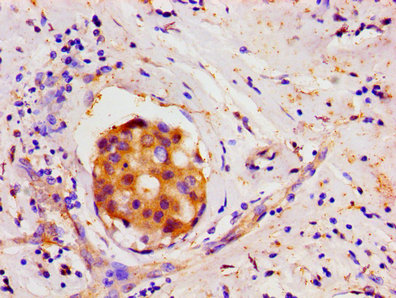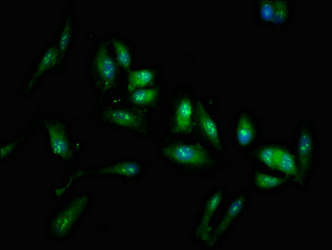
Immunohistochemistry of paraffin-embedded human breast cancer using CSB-PA13619A0Rb at dilution of 1:100
LIN28A Antibody
CSB-PA13619A0RB
ApplicationsImmunoFluorescence, ELISA, ImmunoHistoChemistry
Product group Antibodies
ReactivityHuman
TargetLIN28A
Overview
- SupplierCusabio
- Product NameLIN28A Antibody
- Delivery Days Customer20
- ApplicationsImmunoFluorescence, ELISA, ImmunoHistoChemistry
- CertificationResearch Use Only
- ClonalityPolyclonal
- ConjugateUnconjugated
- Gene ID79727
- Target nameLIN28A
- Target descriptionlin-28 RNA binding posttranscriptional regulator A
- Target synonymsCSDD1, LIN-28, LIN28, ZCCHC1, lin-28A, protein lin-28 homolog A, RNA-binding protein LIN-28, lin-28 homolog A, zinc finger CCHC domain-containing protein 1, zinc finger, CCHC domain containing 1
- HostRabbit
- IsotypeIgG
- Protein IDQ9H9Z2
- Protein NameProtein lin-28 homolog A
- Scientific DescriptionRNA-binding protein that inhibits processing of pre-let-7 miRNAs and regulates translation of mRNAs that control developmental timing, pluripotency and metabolism. Seems to recognize a common structural G-quartet (G4) feature in its miRNA and mRNA targets (Probable). Translational enhancer that drives specific mRNAs to polysomes and increases the efficiency of protein synthesis. Its association with the translational machinery and target mRNAs results in an increased number of initiation events per molecule of mRNA and, indirectly, in mRNA stabilization. Binds IGF2 mRNA, MYOD1 mRNA, ARBP/36B4 ribosomal protein mRNA and its own mRNA. Essential for skeletal muscle differentiation program through the translational up-regulation of IGF2 expression. Suppressor of microRNA (miRNA) biogenesis, including that of let-7, miR107, miR-143 and miR-200c. Specifically binds the miRNA precursors (pre-miRNAs), recognizing an 5-GGAG-3 motif found in pre-miRNA terminal loop, and recruits ZCCHC11/TUT4 uridylyltransferase. This results in the terminal uridylation of target pre-miRNAs. Uridylated pre-miRNAs fail to be processed by Dicer and undergo degradation. The repression of let-7 expression is required for normal development and contributes to maintain the pluripotent state by preventing let-7-mediated differentiation of embryonic stem cells (PubMed:18951094, PubMed:19703396, PubMed:22118463, PubMed:22898984). Localized to the periendoplasmic reticulum area, binds to a large number of spliced mRNAs and inhibits the translation of mRNAs destined for the ER, reducing the synthesis of transmembrane proteins, ER or Golgi lumen proteins, and secretory proteins. Binds to and enhances the translation of mRNAs for several metabolic enzymes, such as PFKP, PDHA1 or SDHA, increasing glycolysis and oxidative phosphorylation. Which, with the let-7 repression may enhance tissue repair in adult tissue (By similarity).
- ReactivityHuman
- Storage Instruction-20°C or -80°C
- UNSPSC41116161







